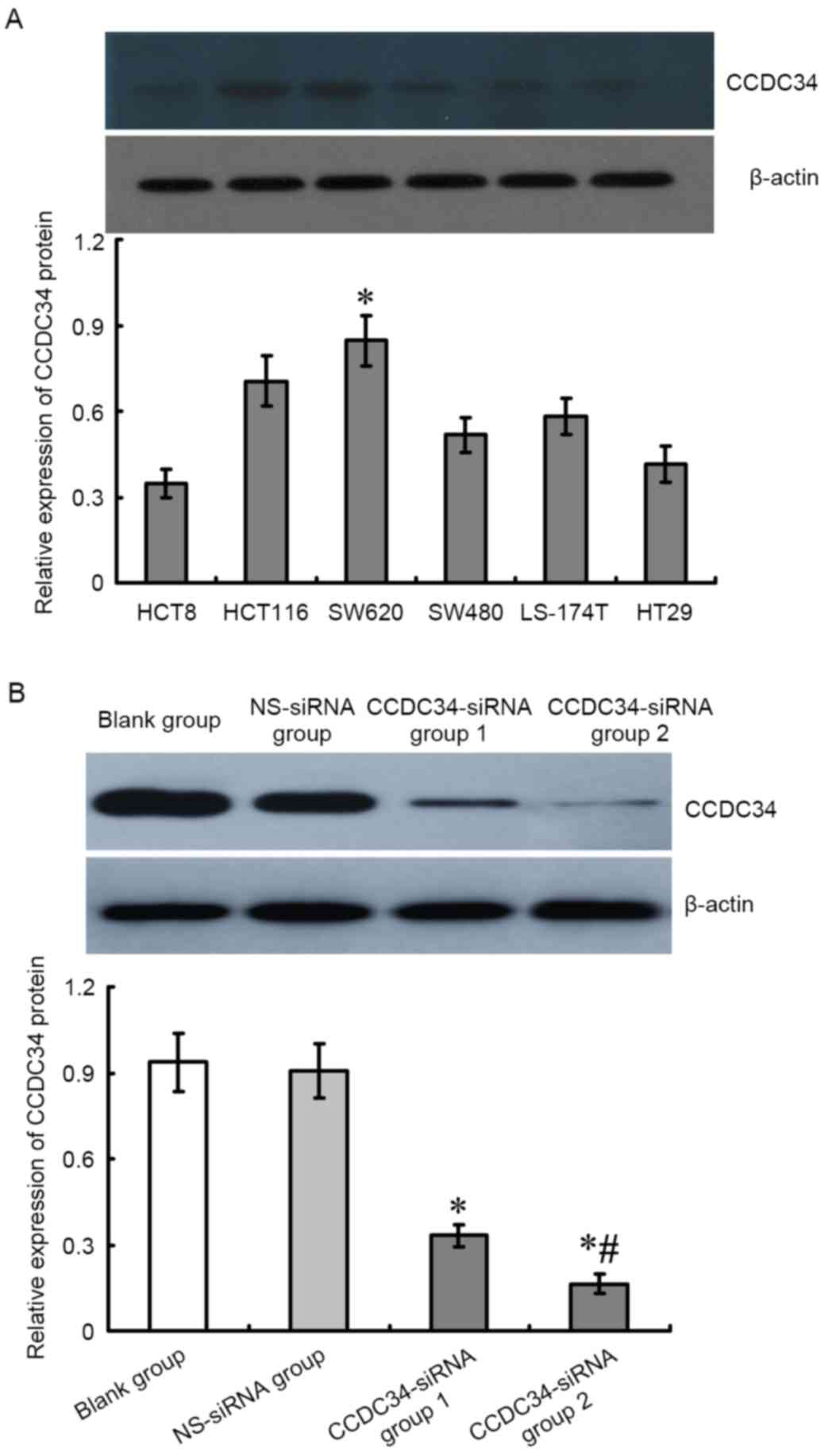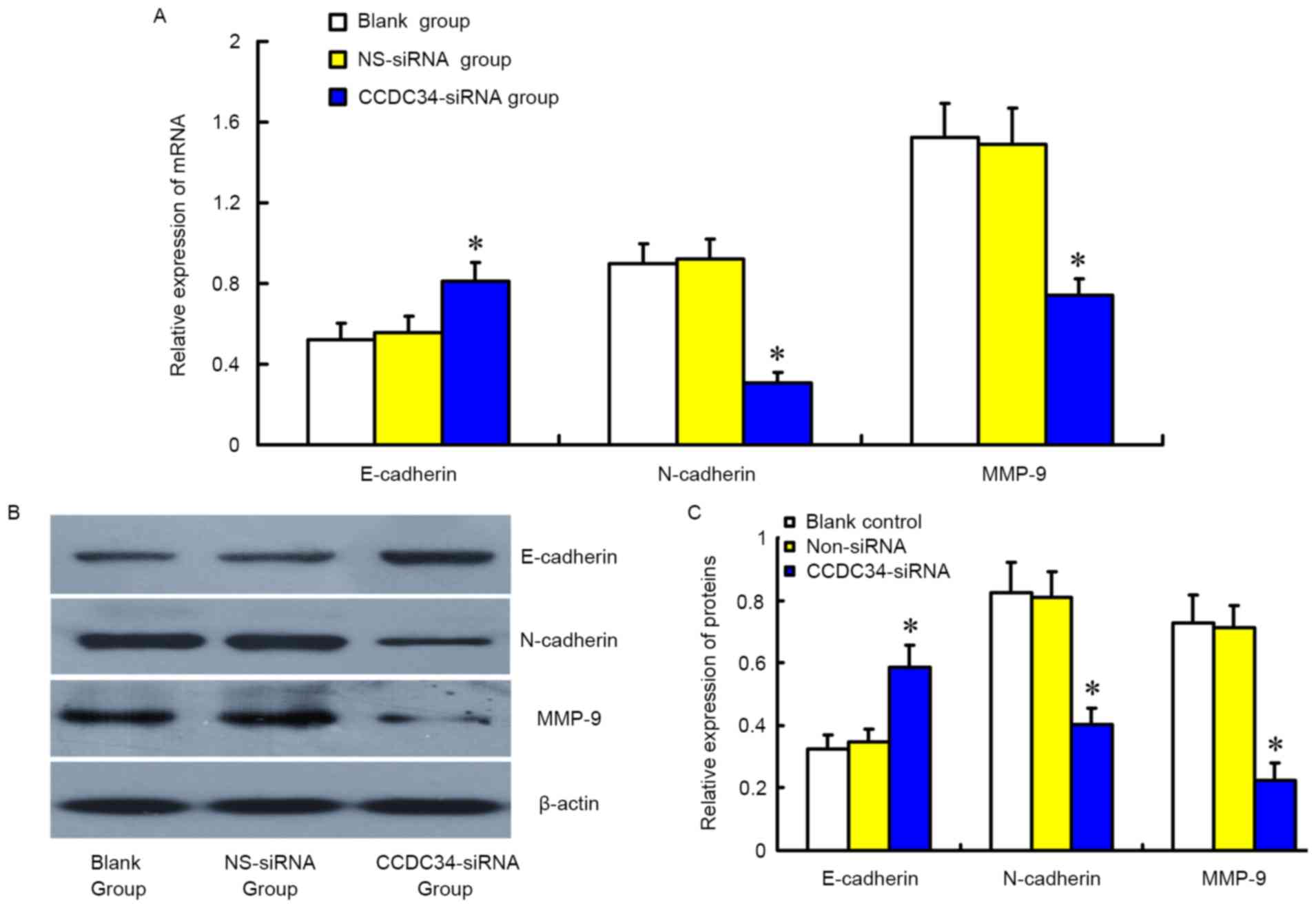|
1
|
Hashim D, Boffetta P, La Vecchia C, Rota
M, Bertuccio P, Malvezzi M and Negri E: The global decrease in
cancer mortality: Trends and disparities. Ann Oncol. 27:926–933.
2016. View Article : Google Scholar : PubMed/NCBI
|
|
2
|
Favoriti P, Carbone G, Greco M, Pirozzi F,
Pirozzi RE and Corcione F: Worldwide burden of colorectal cancer: A
review. Updates Surg. 68:7–11. 2016. View Article : Google Scholar : PubMed/NCBI
|
|
3
|
Schreuders EH, Ruco A, Rabeneck L, Schoen
RE, Sung JJ, Young GP and Kuipers EJ: Colorectal cancer screening:
A global overview of existing programmes. Gut. 64:1637–1649. 2015.
View Article : Google Scholar : PubMed/NCBI
|
|
4
|
Simpkins SJ, Pinto-Sanchez MI, Moayyedi P,
Bercik P, Morgan DG, Bolino C and Ford AC: Poor predictive value of
lower gastrointestinal alarm features in the diagnosis of
colorectal cancer in 1981 patients in secondary care. Aliment
Pharmacol Ther. 45:91–99. 2017. View Article : Google Scholar : PubMed/NCBI
|
|
5
|
Tokodai K, Narimatsu H, Nishida A, Takaya
K, Hara Y, Kawagishi N, Hashizume E and Ohuchi N: Risk factors for
recurrence in stage II/III colorectal cancer patients treated with
curative surgery: The impact of postoperative tumor markers and an
infiltrative growth pattern. J Surg Oncol. 114:368–374. 2016.
View Article : Google Scholar : PubMed/NCBI
|
|
6
|
Vatandoust S, Price TJ and Karapetis CS:
Colorectal cancer: Metastases to a single organ. World J
Gastroenterol. 21:11767–11776. 2015. View Article : Google Scholar : PubMed/NCBI
|
|
7
|
Chen GQ, Tang CF, Shi XK, Lin CY, Fatima
S, Pan XH, Yang DJ, Zhang G, Lu AP, Lin SH and Bian ZX:
Halofuginone inhibits colorectal cancer growth through suppression
of Akt/mTORC1 signaling and glucose metabolism. Oncotarget.
6:24148–24162. 2015. View Article : Google Scholar : PubMed/NCBI
|
|
8
|
He G, Feng C, Vinothkumar R, Chen W, Dai
X, Chen X, Ye Q, Qiu C, Zhou H, Wang Y, et al: Curcumin analog EF24
induces apoptosis via ROS-dependent mitochondrial dysfunction in
human colorectal cancer cells. Cancer Chemother Pharmacol.
78:1151–1161. 2016. View Article : Google Scholar : PubMed/NCBI
|
|
9
|
Sathyanarayanan A, Chandrasekaran KS and
Karunagaran D: microRNA-146a inhibits proliferation, migration and
invasion of human cervical and colorectal cancer cells. Biochem
Biophys Res Commun. 480:528–533. 2016. View Article : Google Scholar : PubMed/NCBI
|
|
10
|
Modjtahedi N, Tokatlidis K, Dessen P and
Kroemer G: Mitochondrial proteins containing
Coiled-Coil-Helix-Coiled-Coil-Helix (CHCH) domains in health and
disease. Trends Biochem Sci. 41:245–260. 2016. View Article : Google Scholar : PubMed/NCBI
|
|
11
|
Yin DT, Xu J, Lei M, Li H, Wang Y, Liu Z,
Zhou Y and Xing M: Characterization of the novel tumor-suppressor
gene CCDC67 in papillary thyroid carcinoma. Oncotarget.
7:5830–5841. 2016. View Article : Google Scholar : PubMed/NCBI
|
|
12
|
Morra F, Luise C, Visconti R, Staibano S,
Merolla F, Ilardi G, Guggino G, Paladino S, Sarnataro D, Franco R,
et al: New therapeutic perspectives in CCDC6 deficient lung cancer
cells. Int J Cancer. 136:2146–2157. 2015. View Article : Google Scholar : PubMed/NCBI
|
|
13
|
Zhong J, Zhao M, Luo Q, Ma Y, Liu J, Wang
J, Yang M, Yuan X, Sang J and Huang C: CCDC134 is down-regulated in
gastric cancer and its silencing promotes cell migration and
invasion of GES-1 and AGS cells via the MAPK pathway. Mol Cell
Biochem. 372:1–8. 2013. View Article : Google Scholar : PubMed/NCBI
|
|
14
|
Park SJ, Jang HR, Kim M, Kim JH, Kwon OH,
Park JL, Noh SM, Song KS, Kim SY, Kim YH and Kim YS: Epigenetic
alteration of CCDC67 and its tumor suppressor function in gastric
cancer. Carcinogenesis. 33:1494–1501. 2012. View Article : Google Scholar : PubMed/NCBI
|
|
15
|
Gong Y, Qiu W, Ning X, Yang X, Liu L, Wang
Z, Lin J, Li X and Guo Y: CCDC34 is up-regulated in bladder cancer
and regulates bladder cancer cell proliferation, apoptosis and
migration. Oncotarget. 6:25856–25867. 2015. View Article : Google Scholar : PubMed/NCBI
|
|
16
|
Livak KJ and Schmittgen TD: Analysis of
relative gene expression data using real-time quantitative PCR and
the 2(-Delta Delta C(T)) method. Methods. 25:402–408. 2001.
View Article : Google Scholar : PubMed/NCBI
|
|
17
|
Bode AM, Dong Z and Wang H: Cancer
prevention and control: Alarming challenges in China. Natl Sci Rev.
3:117–127. 2016. View Article : Google Scholar : PubMed/NCBI
|
|
18
|
Ratti F, Catena M, Di Palo S, Staudacher C
and Aldrighetti L: Impact of totally laparoscopic combined
management of colorectal cancer with synchronous hepatic metastases
on severity of complications: A propensity-score-based analysis.
Surg Endosc. 30:4934–4945. 2016. View Article : Google Scholar : PubMed/NCBI
|
|
19
|
Ahmed I, Howard M, Rehman Z, Ofar F,
Marley P, O'Doherty E and Martin MJ: A comparison of overall and
disease-specific survivals following adjuvant radiotherapy with
neo-adjuvant radiotherapy for rectal cancer. J Clin Oncol. 27 15
suppl:e150082009.
|
|
20
|
Bartoş A, Bartoş D, Szabo B, Breazu C,
Opincariu I, Mironiuc A and Iancu C: Recent achievements in
colorectal cancer diagnostic and therapy by the use of
nanoparticles. Drug Metab Rev. 48:27–46. 2016. View Article : Google Scholar : PubMed/NCBI
|
|
21
|
Verdaguer H, Tabernero J and Macarulla T:
Ramucirumab in metastatic colorectal cancer: Evidence to date and
place in therapy. Ther Adv Med Oncol. 8:230–242. 2016. View Article : Google Scholar : PubMed/NCBI
|
|
22
|
Chen W, Zheng R, Zeng H and Zhang S: The
updated incidences and mortalities of major cancers in China, 2011.
Chin J Cancer. 34:53–507. 2015. View Article : Google Scholar :
|
|
23
|
Kawakami H, Huang S, Pal K, Dutta SK,
Mukhopadhyay D and Sinicrope FA: Mutant BRAF upregulates MCL-1 to
confer apoptosis resistance that is reversed by MCL-1 antagonism
and cobimetinib in colorectal cancer. Mol Cancer Ther.
15:3015–3027. 2016. View Article : Google Scholar : PubMed/NCBI
|
|
24
|
Feng Y, Feng L, Yu D, Zou J and Huang Z:
srGAP1 mediates the migration inhibition effect of Slit2-Robo1 in
colorectal cancer. J Exp Clin Cancer Res. 35:1912016. View Article : Google Scholar : PubMed/NCBI
|
|
25
|
Truebestein L and Leonard TA:
Coiled-coils: The long and short of it. Bioessays. 38:903–916.
2016. View Article : Google Scholar : PubMed/NCBI
|
|
26
|
Peralta S, Clemente P, Sánchez-Martínez A,
Calleja M, Hernández-Sierra R, Matsushima Y, Adán C, Ugalde C,
Fernández-Moreno MÁ, Kaguni LS and Garesse R: Coiled coil
domain-containing protein 56 (CCDC56) is a novel mitochondrial
protein essential for cytochrome c oxidase function. J Biol Chem.
287:24174–24185. 2012. View Article : Google Scholar : PubMed/NCBI
|
|
27
|
Fan XJ, Wang Y, Wang L and Zhu M:
Salidroside induces apoptosis and autophagy in human colorectal
cancer cells through inhibition of PI3K/Akt/mTOR pathway. Oncol
Rep. 36:3559–3567. 2016. View Article : Google Scholar : PubMed/NCBI
|
|
28
|
Jayathilake AG, Senior PV and Su XQ: Krill
oil extract suppresses cell growth and induces apoptosis of human
colorectal cancer cells. BMC Complement Altern Med. 16:3282016.
View Article : Google Scholar : PubMed/NCBI
|
|
29
|
Chen Z, Han S, Huang W, Wu J, Liu Y, Cai
S, He Y, Wu S and Song W: MicroRNA-215 suppresses cell
proliferation, migration and invasion of colon cancer by repressing
Yin-Yang 1. Biochem Biophys Res Commun. 479:482–488. 2016.
View Article : Google Scholar : PubMed/NCBI
|
|
30
|
Jing X, Wu H, Ji X, Wu H, Shi M and Zhao
R: Cortactin promotes cell migration and invasion through
upregulation of the dedicator of cytokinesis 1 expression in human
colorectal cancer. Oncol Rep. 36:1946–1952. 2016. View Article : Google Scholar : PubMed/NCBI
|
|
31
|
Merino D, Lok SW, Visvader JE and Lindeman
GJ: Targeting BCL-2 to enhance vulnerability to therapy in estrogen
receptor-positive breast cancer. Oncogene. 35:1877–1887. 2016.
View Article : Google Scholar : PubMed/NCBI
|
|
32
|
Kvansakul M and Hinds MG: The Bcl-2
family: Structures, interactions and targets for drug discovery.
Apoptosis. 20:136–150. 2015. View Article : Google Scholar : PubMed/NCBI
|
|
33
|
Feng W, Yoshida A and Ueda T: YM155
induces caspase-8 dependent apoptosis through downregulation of
survivin and Mcl-1 in human leukemia cells. Biochem Biophys Res
Commun. 435:52–57. 2013. View Article : Google Scholar : PubMed/NCBI
|
|
34
|
Sam MR, Ahangar P, Nejati V and Habibian
R: Treatment of LS174T colorectal cancer stem-like cells with n-3
PUFAs induces growth suppression through inhibition of survivin
expression and induction of caspase-3 activation. Cell Oncol
(Dordr). 39:69–77. 2016. View Article : Google Scholar : PubMed/NCBI
|
|
35
|
Chen X, Bode AM, Dong Z and Cao Y: The
epithelial-mesenchymal transition (EMT) is regulated by oncoviruses
in cancer. FASEB J. 30:3001–3010. 2016. View Article : Google Scholar : PubMed/NCBI
|
|
36
|
Petrova YI, Schecterson L and Gumbiner BM:
Roles for E-cadherin cell surface regulation in cancer. Mol Biol
Cell. 27:3233–3244. 2016. View Article : Google Scholar : PubMed/NCBI
|
|
37
|
Zhang J, Chen XY, Huang KJ, Wu WD, Jiang
T, Cao J, Zhou LS, Qiu ZJ and Huang C: Expression of FoxM1 and the
EMT-associated protein E-cadherin in gastric cancer and its
clinical significance. Oncol Lett. 12:2445–2450. 2016.PubMed/NCBI
|
|
38
|
Iseki Y, Shibutani M, Maeda K, Nagahara H,
Ikeya T and Hirakawa K: Significance of E-cadherin and CD44
expression in patients with unresectable metastatic colorectal
cancer. Oncol Lett. 14:1025–1034. 2017.PubMed/NCBI
|
|
39
|
Sheng L, Zhang S and Xu H: Effect of
slug-mediated down-regulation of E-cadherin on invasiveness and
metastasis of anaplastic thyroid cancer cells. Med Sci Monit.
23:138–143. 2017. View Article : Google Scholar : PubMed/NCBI
|
|
40
|
Huang H, Svoboda RA, Lazenby AJ, Saowapa
J, Chaika N, Ding K, Wheelock MJ and Johnson KR: Up-regulation of
N-cadherin by collagen I-activated discoidin domain receptor 1 in
pancreatic cancer requires the adaptor molecule Shc1. J Biol Chem.
291:23208–23223. 2016. View Article : Google Scholar : PubMed/NCBI
|
|
41
|
Fernández NB, Lorenzo D, Picco ME, Barbero
G, Dergan-Dylon LS, Marks MP, García-Rivello H, Gimenez L, Labovsky
V, Grumolato L and Lopez-Bergami P: ROR1 contributes to melanoma
cell growth and migration by regulating N-cadherin expression via
the PI3K/Akt pathway. Mol Carcinog. 55:1772–1785. 2016. View Article : Google Scholar : PubMed/NCBI
|
|
42
|
Rabkin SW: Differential expression of
MMP-2, MMP-9 and TIMP proteins in thoracic aortic
aneurysm-comparison with and without bicuspid aortic valve: A
meta-analysis. Vasa. 43:433–442. 2014. View Article : Google Scholar : PubMed/NCBI
|
|
43
|
Araújo RF Jr, Lira GA, Vilaça JA, Guedes
HG, Leitão MC, Lucena HF and Ramos CC: Prognostic and diagnostic
implications of MMP-2, MMP-9, and VEGF-α expressions in colorectal
cancer. Pathol Res Pract. 211:71–77. 2015. View Article : Google Scholar : PubMed/NCBI
|
|
44
|
Guo JQ, Zheng QH, Chen H, Chen L, Xu JB,
Chen MY, Lu D, Wang ZH, Tong HF and Lin S: Ginsenoside Rg3
inhibition of vasculogenic mimicry in pancreatic cancer through
downregulation of VE-cadherin/EphA2/MMP9/MMP2 expression. Int J
Oncol. 45:1065–1072. 2014. View Article : Google Scholar : PubMed/NCBI
|

















